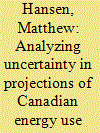| Srl | Item |
| 1 |
ID:
175894


|
|
|
|
|
| Summary/Abstract |
This paper analyzes the uncertainty associated with Reference Case, or baseline, projections of Canadian energy use and production. We use the Canada Energy Regulator's Energy Futures modeling system to explore the impacts of changing key assumptions. The choice of assumptions and magnitude of change are guided by the scenarios in the Energy Modeling Forum (EMF) 34 project. We find important variations across all scenarios. In particular, we note that Canada's role as an energy producer is important for interpreting projection and scenario results. Overall, this analysis shows that it is important to test key assumptions in a typical Reference Case projection. However, this analysis also highlights many complexities in energy system modeling. It is also important to consider the potential interplay between key variables. This speaks to the importance of broader scenario analysis, where multiple assumptions are changed in an internally consistent way, as a useful complement to the focused scenario analysis found in this paper.
|
|
|
|
|
|
|
|
|
|
|
|
|
|
|
|
| 2 |
ID:
111387


|
|
|
|
|
| Publication |
2012.
|
| Summary/Abstract |
Offshore wind power is anticipated to make a major contribution to the UK's renewable energy targets but, contrary to expectations, costs have risen dramatically in recent years. This paper considers the context of these cost increases, and describes a disaggregated levelised cost model used by the authors to explore the effect of different assumptions about the direction and scale of the major cost drivers. The paper identifies the competing upward and downward pressures on costs in the medium term, and discusses the range of future costs that emerges from the analysis. The paper goes on to analyse the implications of these cost projections for the policy support levels that offshore wind may require. The paper suggests that there are good reasons why it is reasonable to expect a gradual fall in costs in the period to the mid-2020s, although it is unlikely that costs will fall as rapidly as they have risen, or that it will be a smooth downward trajectory. A key challenge is to reconcile the scale and pace of development desired for UK offshore wind with the potential growth rate that the supply chain can sustain without creating upward pressure on costs.
|
|
|
|
|
|
|
|
|
|
|
|
|
|
|
|
| 3 |
ID:
150817


|
|
|
|
|
| Summary/Abstract |
Growing shortfall of electricity in Pakistan affects almost all sectors of its economy. For proper policy formulation, it is imperative to have reliable forecasts of electricity consumption. This paper applies Holt-Winter and Autoregressive Integrated Moving Average (ARIMA) models on time series secondary data from 1980 to 2011 to forecast total and component wise electricity consumption in Pakistan. Results reveal that Holt-Winter is the appropriate model for forecasting electricity consumption in Pakistan. It also suggests that electricity consumption would continue to increase throughout the projected period and widen the consumption-production gap in case of failure to respond the issue appropriately. It further reveals that demand would be highest in the household sector as compared to all other sectors and the increase in the energy generation would be less than the increase in total electricity consumption throughout the projected period. The study discuss various options to reduce the demand-supply gap and provide reliable electricity to different sectors of the economy.
|
|
|
|
|
|
|
|
|
|
|
|
|
|
|
|